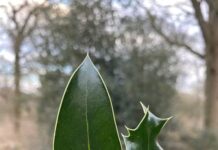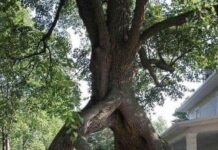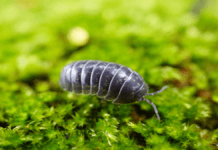Well, according to a common saying, no one should ever forget their roots. When I see this striking tree spotted in southern china, that saying came to my mind. This is actually a banyan tree situated in Guangxi province. This tree does not stand on a trunk. Instead of that, this whole tree stands on a web of roots.

Actually, in the beginning, the roots of this tree grew against a wall. And later the wall was demolished and the tree was successfully and carefully uprooted to a new location, the Northern Gulf Marine and Cultural Park in Fangchenggang city. Then its roots became its trunk of it while giving the strange appearance.

Now let’s discuss some further details about these banyan trees. Banyan trees are native to India. But they exist throughout South Asia. They have a vast history and as well as many uses. They put forth roots that act as a secondary trunk to the tree and support its expansive limbs. They have large and leathery leaves and banyan trees produce figs which are popular among monkeys and birds. And also these trees produce flowers that attract wasps.
In most countries, these banyan trees are planted near temples, villages, roadsides and homes. In most rural villages, these banyan trees act as meeting places for the community. In villages, people gather around the shade of the banyan tree to discuss issues, relax and take decisions. You may wonder where the name came from. It came from some merchants called Banias who used to rest under these trees and discuss their strategies. According to history, Alexander the Great had also camped under a banyan tree which was absolutely large enough to provide shelter to his army of seven thousand.

Banyan trees have lots of uses. Their milk is used in gardening and also they produce a special type of rubber. In Nepal, people use this milky sap to polish brass and copper. And also roots of these trees are used to make ropes to bind wood bundles. And the wood and bark of banyan trees are used to make paper. Nepal women crush the banyan tree roots and prepare a skin and hair conditioner.
Banyan trees also have many medicinal values. The seeds and barks of these trees use to make a tonic to cool the body and to treat diabetes patients. The milky sap is used to treat external skin bruising and inflammations. And also the roots and sap are used to treat toothaches, dysentery as well as skin ulcers. In India and Pakistan, twigs of the banyan tree are sold as toothpicks to promote dental health.

The banyan tree is the national tree in India and they use branches and linked roots of the tree as a symbol of the country’s unity. It is also considered representative of eternal life and sacred. When talking about the lifespan of banyan trees, it is difficult to say the exact lifespan. Averagely it is estimated as 200 to 500 years. But some people argue that banyan trees can live for more than 1000 years. Thimmamma Maririmanu, one of the famous banyan trees lives in southern India is known as more than 550 years old. In 1989 it was added to the Guinness world record book as the largest tree in the world. But the title was taken by a giant sequoia tree in 2006 which was found in California.
Within five years, a banyan can grow from a seed to a young tree. But the growth rate depends on the availability of space and water. If a banyan seed lands directly on the ground, it is like to be shaded out by other plants. But if a seed lands on another tree’s branch, it will continue to grow roots continuously as long as they are alive. These roots finally end up killing the original host tree and those roots become woodier and thicker when they age and it becomes difficult to identify which part of the tree is the primary trunk.

If you wish to grow a banyan tree in your garden, you must have plenty of space. And also you must make sure to locate it away from paved areas and buildings. The most important thing you must remember is that it will end up killing the host tree. Usually, they grow up best in humid areas and need lots of sunlight. They cannot survive in cold weather. So before planting a banyan tree you should consider all of these factors.



















